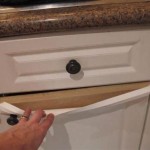How to Put a Darker Stain on Kitchen Cabinets
Updating kitchen cabinets with a darker stain can dramatically transform the look and feel of a kitchen. This process requires careful preparation, the right materials, and a systematic approach to achieve a professional-looking finish. The following details a comprehensive guide for applying a darker stain to kitchen cabinets, covering everything from assessing the existing finish to applying the final coat.
Assessing the Existing Finish and Cabinet Material
Before embarking on the staining project, a thorough assessment of the existing cabinet finish and material is critical. This step will determine the necessary preparation methods and the type of stain that will adhere properly. Examine the cabinets closely to identify the current finish; this could be a varnish, polyurethane, paint, or a previous stain. Also, determine the type of wood used in the cabinets. Solid wood cabinets, such as oak, maple, or cherry, will accept stain differently than veneer or laminate cabinets.
Cabinets with a clear coat (varnish or polyurethane) generally require thorough sanding to remove the existing finish and create a porous surface for the new stain to penetrate. Painted cabinets require even more extensive preparation, often involving chemical stripping in addition to sanding. Veneer cabinets present a unique challenge, as the thin layer of wood veneer can be easily damaged by aggressive sanding. Laminate cabinets, on the other hand, cannot be stained directly and may require a different approach, such as using a specialized laminate refinishing product or paint.
If the existing finish is already a dark stain and in good condition, it may be possible to apply a gel stain or a tinted topcoat directly over it, after proper cleaning and scuff sanding. This approach bypasses the need for extensive stripping and sanding, but it is crucial to test the compatibility of the new product with the existing finish in an inconspicuous area before proceeding with the entire project.
The type of wood also influences the staining process. Open-grained woods like oak tend to absorb more stain, resulting in a darker and more textured appearance. Close-grained woods like maple may require a pre-stain wood conditioner to ensure even stain absorption and prevent blotchiness. Understanding the characteristics of the wood is key to achieving the desired color and finish.
Preparing the Cabinets for Staining
Proper preparation is arguably the most important step in achieving a successful stain job. This involves removing the cabinets, cleaning them thoroughly, and sanding them to create a receptive surface for the stain. Begin by carefully removing all cabinet doors, drawers, and hardware, such as knobs, pulls, and hinges. Label each door and drawer to ensure they are reinstalled in the correct locations. Clean the cabinets thoroughly with a degreasing cleaner to remove any dirt, grease, or grime. This step is crucial for ensuring proper adhesion of the stain.
Next, sand the cabinets to remove the existing finish and create a smooth, even surface. Start with a coarser grit sandpaper (e.g., 80-grit or 100-grit) to remove the bulk of the old finish. Use a random orbital sander for large, flat surfaces and a detail sander or sanding block for corners and edges. Be careful not to sand too aggressively, especially on veneer cabinets, as this can damage the thin layer of wood. Once the old finish is removed, switch to a finer grit sandpaper (e.g., 150-grit or 180-grit) to smooth out any scratches and create a uniform surface. Finally, use an even finer grit sandpaper (e.g., 220-grit) for the final sanding to achieve a very smooth and polished surface.
After sanding, thoroughly remove all sanding dust with a tack cloth or a shop vacuum. Dust particles can interfere with the stain absorption and create an uneven finish. For cabinets with intricate details or carvings, use a brush to remove dust from hard-to-reach areas. After removing the dust, wipe down the cabinets with a damp cloth to raise the wood grain. Allow the cabinets to dry completely, then lightly sand them again with fine-grit sandpaper to remove any raised grain. This step will ensure a smooth and even stain application.
If the cabinets are made of wood known to be prone to blotching, such as pine or maple, apply a pre-stain wood conditioner according to the manufacturer's instructions. This will help to control the stain absorption and ensure a more even color. Allow the wood conditioner to dry completely before applying the stain.
Applying the Darker Stain
Once the cabinets are properly prepared, the stain can be applied. Select a high-quality stain in the desired darker color. Oil-based stains tend to provide richer color and better penetration, while water-based stains are lower in VOCs (volatile organic compounds) and easier to clean up. Consider a gel stain for vertical surfaces or when you want a more even color on patched or filled areas. Test the stain on a hidden area of the cabinet or a scrap piece of wood to ensure it achieves the desired color and effect.
Apply the stain evenly with a brush, rag, or foam applicator, working with the grain of the wood. Avoid applying too much stain at once, as this can lead to drips and runs. Allow the stain to penetrate the wood for the recommended amount of time, as specified by the manufacturer. The longer the stain sits on the wood, the darker the color will be. However, do not exceed the recommended penetration time, as this can result in an uneven or muddy finish.
After the stain has penetrated the wood, wipe off the excess stain with a clean, lint-free cloth. Use a gentle, even pressure to remove the excess stain, working with the grain of the wood. Pay close attention to corners and crevices, ensuring that no stain accumulates in these areas. The goal is to remove the excess stain while leaving enough stain to achieve the desired color.
Allow the stain to dry completely according to the manufacturer's instructions. Drying times can vary depending on the type of stain, the temperature, and the humidity. Once the stain is dry, lightly sand the cabinets with fine-grit sandpaper (e.g., 320-grit or 400-grit) to smooth out any imperfections and prepare the surface for the clear coat. Remove all sanding dust with a tack cloth before proceeding to the next step.
For a deeper, richer color, consider applying a second coat of stain. Follow the same procedure as the first coat, allowing the stain to penetrate the wood for the recommended amount of time and wiping off the excess. Allow the second coat of stain to dry completely before proceeding to the clear coat.
Applying a Protective Clear Coat
Applying a clear coat is essential to protect the stained cabinets from moisture, scratches, and wear. Choose a high-quality clear coat that is compatible with the stain you have used. Polyurethane is a popular choice for kitchen cabinets due to its durability and resistance to water and chemicals. Water-based polyurethane is a good option for its low odor and easy cleanup, while oil-based polyurethane offers superior durability and a slightly amber tint that can enhance the color of the stain.
Apply the clear coat in thin, even coats with a brush, sprayer, or foam applicator. Avoid applying too much clear coat at once, as this can lead to drips and runs. Work with the grain of the wood and ensure that all surfaces are evenly coated. Allow the first coat of clear coat to dry completely according to the manufacturer's instructions.
Once the first coat of clear coat is dry, lightly sand the cabinets with fine-grit sandpaper (e.g., 320-grit or 400-grit) to smooth out any imperfections and prepare the surface for the next coat. Remove all sanding dust with a tack cloth before applying the second coat. Apply at least two coats of clear coat for adequate protection, following the same procedure for each coat.
Allow the final coat of clear coat to dry completely for the recommended amount of time before reinstalling the cabinets and hardware. Handle the cabinets with care to avoid scratching or damaging the finish. Once the cabinets are reinstalled, inspect them for any imperfections and touch up any areas as needed. With proper preparation and application, the newly stained kitchen cabinets will provide years of beauty and durability.

Staining Your Wood Cabinets Darker Young House Love

How To Stain Wood Cabinets True Value

How To Stain Oak Cabinetry Tutorial The Kim Six Fix

Diy Staining Oak Cabinets Eclectic Spark

Staining Your Wood Cabinets Darker Young House Love

Gel Stain Kitchen Cabinets Without Sanding Fast Easy Diy

How To Stain Dark Or Yellow Kitchen Cabinets Lighter

Staining Your Wood Cabinets Darker Young House Love

Painted Wood Cabinets Vs Stained A Questionnaire Kylie M Interiors

Updating Wood Kitchen Cabinets Love Remodeled
Related Posts








